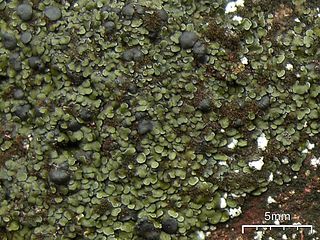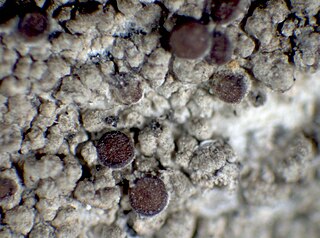
Gyalectales is an order of lichen-forming fungi in the class Lecanoromycetes. It contains 5 families, 18 genera and about 550 species.

Cliostomum is a genus of lichenized fungi in the family Ramalinaceae. It has about 25 species.

Fuscopannaria is a genus of lichen-forming fungi in the family Pannariaceae. It has 55 species.

Szczawinskia is a genus of leaf-dwelling lichens in the family Pilocarpaceae. The genus contains five species. The genus was circumscribed by Canadian mycologist Alvin Funk in 1984, with Szczawinskia tsugae assigned as the type species.
Schismatomma is a genus of mostly lichen-forming fungi in the family Roccellaceae.
Sagiolechia is a genus of lichen-forming fungi in the family Sagiolechiaceae. The genus was circumscribed by lichenologist Abramo Bartolommeo Massalongo in 1854, who assigned Sagiolechia protuberans as the type species. The family Sagiolechiaceae was proposed in 2010 to contain Sagiolechia as the type genus, and genus Rhexophiale; molecular phylogenetic analysis showed that these two genera formed a distinct clade in the Ostropales.

Spilonema is a genus of lichen-forming fungi in the family Coccocarpiaceae. The genus was circumscribed by Jean-Baptiste Édouard Bornet in 1856.

Fuscidea is a genus of crustose lichens in the family Fuscideaceae. It has about 40 species. The genus was circumscribed in 1972 by lichenologists Volkmar Wirth and Antonín Vězda, with Fuscidea aggregatilis assigned as the type species.

Ropalospora is a genus of lichen-forming fungi, and the sole member of the monogeneric family Ropalosporaceae. The genus was circumscribed by Italian lichenologist Abramo Bartolommeo Massalongo in 1860. The family was proposed by Josef Hafellner in 1984.
Arctomia is a genus of lichen-forming fungi in the family Arctomiaceae. The genus was originally circumscribed by Theodor Magnus Fries in 1861. Arctomia has a circumpolar distribution.

Arthrorhaphis is a genus of lichen-forming fungi in the monotypic family Arthrorhaphidaceae. It has 13 species. The genus was circumscribed by Theodor Magnus Fries in 1860. The family was proposed by lichenologists Josef Poelt and Josef Hafellner in 1976. Species in this family have a widespread distribution in temperate and montane habitats. They grow symbiotically with green algae, or parasitically on other lichens. The family Arthrorhaphidaceae has an uncertain taxonomic placement in the class Lecanoromycetes; that is, it is incertae sedis with respect to ordinal placement.

Schaereria is a genus of lichen-forming fungi. It is the sole genus in the family Schaereriaceae, which itself is the only family in the Schaereriales, an order in the subclass Ostropomycetidae of the class Lecanoromycetes. Most Schaereria species are crustose lichens that live on rocks. Schaereria was first proposed by Gustav Wilhelm Körber in 1855 and was later taken up by other lichenologists despite periods of disuse.
Toensbergia is a genus of lichen-forming fungi in the family Sporastatiaceae. The genus was circumscribed by Mika Bendiksby and Einar Timdal in 2013. The genus name honours Norwegian lichenologist Tor Tønsberg, "in appreciation of his important work on sorediate, corticolous lichens". The type species is Toensbergia leucococca, which was formerly classified in genus Hypocenomyce, presumably due to its resemblance to Hypocenomyce xanthococca.
Steineropsis is a genus of lichen-forming fungi in the family Pannariaceae. It has two species. The genus was circumscribed by Toby Spribille and Lucia Muggia in 2010, with Steineropsis alaskana assigned as the type species. The type specimen of this lichen was found in Skagway, Alaska, where it was growing on a rock in a snowbed at an altitude of 1,051 m (3,448 ft). The generic name alludes to a resemblance to the genus Steinera. A second species, Steineropsis laceratula, also found in Alaska, was added to the genus in 2020. Molecular phylogenetic analysis showed that Steineropsis has a sister taxon relationship to genus Protopannaria.
Sagiolechia phaeospora is a species of crustose lichen in the family Sagiolechiaceae. It is found in the alpine tundra of Alaska.

Yarrumia is a genus of lichen-forming fungi in the subfamily Lobarioideae of the family Peltigeraceae. It has two foliose species that are found in New Zealand. Lichen products that have been detected in the genus include polyporic acid, pigments and stictane triterpenoids. The genus was circumscribed in 2015 by David John Galloway. The generic name Yarrumia honours James Murray (1923–1961) "who first detected polyporic acid in the two species comprising the genus, and who contributed so much to New Zealand lichenology, subsequent to his initial interest in the chemistry of Yarrumia coronata dating from 1949".

Andreiomyces is the sole genus in Andreiomycetaceae, a family in the order Arthoniales. Andreiomyces contains two lichen-forming fungi, both of which were previously classified in the genus Lepraria.
Crittendenia is a genus of lichenicolous (lichen-dwelling) fungi in the monogeneric family Crittendeniaceae. The genus was circumscribed in 2021 to contain two species, C. lichenicola, and the type, C. coppinsii; these species were previously classified in the genus Chionosphaera. An additional 16 species were added to the genus the following year. The genus name honours British lichenologist Peter Crittenden.

Reichlingia is a genus of lichen-forming fungi in the family Arthoniaceae. It has seven species. The genus was originally circumscribed by Paul Diederich and Christoph Scheidegger in 1996, with Reichlingia leopoldii as the type, and at that time, only species. The fungus was at first thought to be a lichenicolous (lichen-dwelling) fungus, but is now considered a lichenised hyphomycete.

Myochroidea is a genus of lichen-forming fungi of uncertain familial placement in the order Lecanorales. It has four species of grey or brown-grey crustose lichens.












